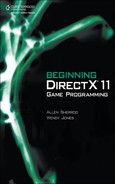0%
12Chapters
0-1Hours read
0kTotal Words
Book Description
Discover the exciting world of game programming and 3D graphics creation using DirectX 11! BEGINNING DIRECTX 11 GAME PROGRAMMING is an introductory guide to creating fantastic graphics, amazing creatures, and realistic worlds for games. Written specifically for the beginner programmer, the book uses step-by-step instructions to teach the basics of DirectX 11, introducing skills that can be applied to creating games for both PC and game console platforms like the Xbox 360. Updated for all the newest DirectX technology, the book includes coverage of improved professional coding practices, an overview of the DirectX components and tools, sprites, text and font rendering, audio, shaders and effects, and much more.
Table of Contents
- Copyright
- Acknowledgments
- About the Authors
- Introduction
- 1. The What, Why, and How of DirectX
- 2. Your First DirectX Program
- 3. 2D Rendering
- 4. Text and Font Rendering
- 5. Input Detection and Response
- 6. 3D Primer
- 7. Shaders and Effects
- 8. Cameras and Models in Direct3D
